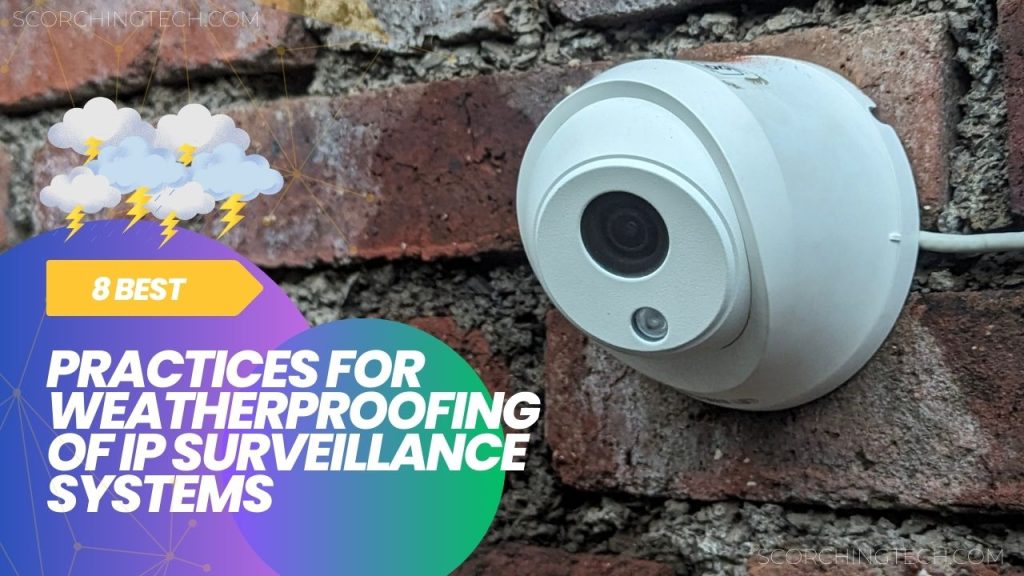Best practices for weatherproofing of CCTV systems, Weatherproofing of camera is very important task in any video surveillance system. As you know video surveillance systems has indoor applications as well as outdoor applications. In indoor applications CCTV Camera is by default protected from harsh weather conditions like summer heat, rain, and storms. But the same case not goes with the CCTV cameras used in outdoor applications. Outdoor CCTV cameras are directly exposed to weather conditions and very likely to get damaged by them. So primary step to protect outdoor camera from such harsh conditions. Weatherproofing allows CCTV system to withstand any harsh environmental conditions.
Here are 8 best practices for weatherproofing of CCTV systems:
Use Weatherproof Housings
Weatherproof housing is nothing but a metal enclosure with IP67 or IP68 rating, Inside which a camera is placed. This enclosure protects the camera and its lens from dust and water. this enclosure are robust to withstand harsh environmental conditions like heavy rain, storm. It also protects camera from physical damage. housings are easy to install. Below image shows how weatherproof housing looks a like.
- Ensure cameras have weatherproof housings with a high IP (Ingress Protection) rating, such as IP67 or IP68. This rating indicates protection against dust and water.
Proper Placement
Choosing proper placement to install camera is important, if you have eaves, overhands, or any other sheltered areas these can be used to minimize the exposure to rain, snow and direct sunlight. Below image shows how weatherproof housing looks a like.
- Install cameras under eaves, overhangs, or other sheltered areas to minimize exposure to rain, snow, and direct sunlight.
Seal Connections
Protecting CCTV connections from water is crucial for maintaining the functionality and longevity of your surveillance system. Protecting connections from moisture, dust and rain water. To do so we have to use waterproof connectors, gaskets and sealants around the connections.
- Waterproof Ethernet Connectors: These connectors have rubber grommets and seals to prevent water to enter.
- Silicone Sealant: Apply silicone sealant around the connectors to ensure a watertight seal.
- Weatherproof Junction box can be used to place and secure connections.
Tilt Cameras Downward
Outdoor cameras are exposed to dust and water directly. Dust and water settles on lens over the period of time adding to regular maintenance. This can be avoided or minimize to some extend by positioning cameras to tilt slightly downward direction creating slope, this will prevent dust or water from settling on the camera.
- Position cameras to tilt slightly downward to prevent water from settling on the lens.
Use Sun Shields and Anti-fog Sprays
Outdoor camera exposed to Sun glare and direct sunlight as we can not avoid it fully. Installing shields will help to protect the camera against direct sunlight. Another major factor to affect visibility is fogging on camera lens, fogging is the result of temperature differences between the air and the camera supported by presence of high humidity. result of fog is generation of liquid droplets on lens or protective glass. to avoid creation of fog anti-fog sprays are used, it will help to prevent the fog and maintain clear visibility.
- Incorporate sun shields to protect against direct sunlight and anti-fog sprays to maintain clear visibility.
Grounding and Surge Protection
Outdoor Cameras are installed at height are likely to be structed by lightnings due to its positioning. We recommend to use proper grounding and using surge protectors.
Regular Maintenance
Regular maintenance of the outdoor cameras has to be done. It helps to keep functionality of the cameras at its optimal state. regular maintenance of camera increase the overall performance and life, makes it reliable to perform in any condition.
- Maintenance involves regular inspections of CCTV hardware, clean cameras to prevent dust and debris buildup.
Built-in Heaters
CCTV cameras installed in cold environment are victim to frost and freeze, to prevent frost and freezing built-in heaters are used. There are OEMs that makes cameras with built-in heaters to be used in coldest environment.
Implementing these practices can help ensure your IP surveillance system remains effective and reliable in various weather conditions. If you have any more questions or need further details, feel free to ask in comment section below!

